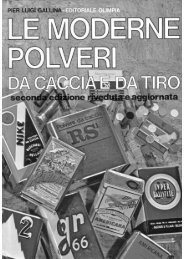Reloading Guide - Armi e Strumenti
Reloading Guide - Armi e Strumenti
Reloading Guide - Armi e Strumenti
Create successful ePaper yourself
Turn your PDF publications into a flip-book with our unique Google optimized e-Paper software.
10<br />
Properties and Storage of<br />
Smokeless Powder<br />
How to Check Smokeless Powder<br />
for Deterioration<br />
Although modern smokeless powders are basically free from<br />
deterioration under proper storage conditions, safe practices<br />
require a recognition of the signs of deterioration and its<br />
possible effects.<br />
Powder deterioration can be checked by opening the cap on<br />
the container and smelling the contents.<br />
Powder undergoing deterioration has an irritating acidic<br />
odor. (Don’t confuse this with common solvent odors such as<br />
alcohol, ether and acetone).<br />
Check to make certain that powder is not exposed to extreme<br />
heat as this may cause deterioration. Such exposure produces<br />
an acidity which accelerates further reaction and has been<br />
known, because of the heat generated by the reaction, to<br />
cause spontaneous combustion.<br />
Never salvage powder from old cartridges and do not attempt<br />
to blend salvaged powder with new powder. Don’t accumulate<br />
old powder stocks. The best way to dispose of deteriorated<br />
smokeless powder is to bum it out in the open at an isolated<br />
location in small shallow piles (not over 1” deep). The quantity<br />
burned in any one pile should never exceed one pound. Use an<br />
ignition train of slow burning combustible material so that the<br />
person may retreat to a safe distance before powder is ignited.<br />
Considerations for Storage of<br />
Smokeless Powder<br />
Smokeless powder is intended to function by burning, so it<br />
must be protected against accidental exposure to flame, sparks<br />
or high temperatures.<br />
For these reasons, it is desirable that storage enclosures be<br />
made of insulating materials to protect the powder from<br />
external heat sources.<br />
Once smokeless powder begins to burn, it will normally<br />
continue to burn (and generate gas pressure) until it is<br />
consumed.<br />
D.O.T. approved containers are constructed to open up at low<br />
internal pressures to avoid the effects normally produced by<br />
the rupture or bursting of a strong container.<br />
Storage enclosures for smokeless powder should be<br />
constructed in a similar manner:<br />
1. Of fire-resistant and heat-insulating materials to<br />
protect contents from external heat.<br />
2. Sufficiently large to satisfactorily vent the gaseous<br />
products of combustion which would result if<br />
the quantity of smokeless powder within the<br />
enclosure accidentally ignited.<br />
If a small, tightly enclosed storage enclosure is loaded to<br />
capacity with containers of smokeless powder, the walls of<br />
the enclosure will expand or move outwards to release the<br />
gas pressure - if the powder in storage is accidentally ignited.<br />
Under such conditions, the effects of the release of gas<br />
pressure are similar or identical to the effects produced by<br />
an explosion.<br />
Hence only the smallest practical quantities of smokeless<br />
powder should be kept in storage, and then in strict compliance<br />
with all applicable regulations and recommendations of the<br />
National Fire Protection Association.<br />
Properties and Storage of<br />
Smokeless Powder<br />
Recommendations for Storage of<br />
Smokeless Powder<br />
STORE IN A COOL, DRY PLACE. Be sure the storage area<br />
selected is free from any possible sources of excess heat and<br />
is isolated from open flame, furnaces, hot water heaters, etc.<br />
Do not store smokeless powder where it will be exposed to<br />
the sun’s rays. Avoid storage in areas where mechanical or<br />
electrical equipment is in operation. Restrict from the storage<br />
areas heat or sparks which may result from improper, defective<br />
or overloaded electrical circuits.<br />
DO NOT STORE SMOKELESS POWDER IN THE SAME<br />
AREA WITH SOLVENTS, FLAMMABLE GASES OR HIGHLY<br />
COMBUSTIBLE MATERIALS. STORE ONLY IN DEPARTMENT<br />
OF TRANSPORTATION APPROVED CONTAINERS.<br />
Do not transfer the powder from an approved container into<br />
one which is not approved.<br />
DO NOT SMOKE IN AREAS WHERE POWDER IS STORED OR<br />
USED. Place appropriate “NO SMOKING” signs in these areas.<br />
THE STORAGE CABINETS SHOULD BE CONSTRUCTED OF<br />
INSULATING MATERIALS AND WITH A WEAK WALL, SEAMS<br />
OR JOINTS TO PROVIDE AN EASY MEANS OF SELFVENTING.<br />
DO NOT KEEP OLD OR SALVAGED POWDERS. Check old<br />
powders for deterioration regularly. Destroy deteriorated<br />
powders immediately.<br />
OBEY ALL REGULATIONS REGARDING QUANTITY AND<br />
METHODS OF STORING. Do not store all your powders in one<br />
place. If you can, maintain separate storage locations. Many<br />
small containers are safer than one or more large containers.<br />
KEEP YOUR STORAGE AND USE AREA CLEAN. Clean up spilled<br />
powder promptly. Make sure the surrounding area is free of<br />
trash or other readily combustible materials.<br />
The above information has been provided with permission<br />
from SAAMI: SPORTING ARMS AND AMMUNITION<br />
MANUFACTURERS’ INSTITUTE, INC. P.O. Box 838, Branford,<br />
CT 06405.<br />
11




